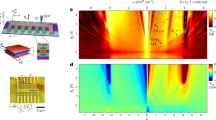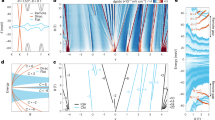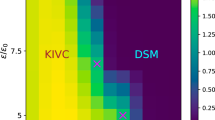Abstract
The realization of graphene has provided a bench-top laboratory for quantum electrodynamics. The low-energy excitations of graphene are two-dimensional massless Dirac fermions with opposite chiralities at the ±K valleys of the graphene Brillouin zone. It has been speculated that the electron–electron interactions in graphene could spontaneously break the chiral symmetry to induce a finite mass for Dirac fermions, which is also known as the relativistic Mott transition. However, the phenomenon has not been observed in pristine graphene because the interaction strength is insufficient. Here, we report the realization of strongly correlated artificial graphene and the observation of the relativistic Mott transition in twisted WSe2 tetralayers. Using magnetotransport, we show that the first Γ-valley moiré valence band mimics the low-energy graphene band structure. At half band filling, the system exhibits hallmarks of massless Dirac fermions, including an anomalous Landau fan originated from a π Berry phase and a square-root density dependence of the cyclotron mass. We tune the interaction across the semimetal–insulator transition by reducing the twist angle below about 2.7°. The emergent insulator is compatible with an antiferromagnetic Mott insulator. Our results open the possibility of studying strongly correlated Dirac fermions in a condensed matter system.
This is a preview of subscription content, access via your institution
Access options
Access Nature and 54 other Nature Portfolio journals
Get Nature+, our best-value online-access subscription
$32.99 / 30 days
cancel any time
Subscribe to this journal
Receive 12 print issues and online access
$259.00 per year
only $21.58 per issue
Buy this article
- Purchase on SpringerLink
- Instant access to full article PDF
Prices may be subject to local taxes which are calculated during checkout





Similar content being viewed by others
Data availability
All data are available in the article and its Supplementary Information. Source data are provided with this paper.
References
Novoselov, K. S. et al. Two-dimensional gas of massless Dirac fermions in graphene. Nature 438, 197–200 (2005).
Zhang, Y., Tan, Y.-W., Stormer, H. L. & Kim, P. Experimental observation of the quantum Hall effect and Berry’s phase in graphene. Nature 438, 201–204 (2005).
Castro Neto, A. H., Guinea, F., Peres, N. M. R., Novoselov, K. S. & Geim, A. K. The electronic properties of graphene. Rev. Mod. Phys. 81, 109–162 (2009).
Nambu, Y. & Jona-Lasinio, G. Dynamical model of elementary particles based on an analogy with superconductivity. I. Phys. Rev. 122, 345–358 (1961).
Nambu, Y. & Jona-Lasinio, G. Dynamical model of elementary particles based on an analogy with superconductivity. II. Phys. Rev. 124, 246–254 (1961).
Herbut, I. F. Interactions and phase transitions on graphene’s honeycomb lattice. Phys. Rev. Lett. 97, 146401 (2006).
Herbut, I. F., Juričić, V. & Roy, B. Theory of interacting electrons on the honeycomb lattice. Phys. Rev. B 79, 085116 (2009).
Herbut, I. F., Juričić, V. & Vafek, O. Relativistic Mott criticality in graphene. Phys. Rev. B 80, 075432 (2009).
Juričić, V., Herbut, I. F. & Semenoff, G. W. Coulomb interaction at the metal–insulator critical point in graphene. Phys. Rev. B 80, 081405 (2009).
Ryu, S., Mudry, C., Hou, C.-Y. & Chamon, C. Masses in graphenelike two-dimensional electronic systems: topological defects in order parameters and their fractional exchange statistics. Phys. Rev. B 80, 205319 (2009).
Weeks, C. & Franz, M. Interaction-driven instabilities of a Dirac semimetal. Phys. Rev. B 81, 085105 (2010).
Semenoff, G. W. Chiral symmetry breaking in graphene. Phys. Scr. 2012, 014016 (2012).
González, J. Electron self-energy effects on chiral symmetry breaking in graphene. Phys. Rev. B 85, 085420 (2012).
Assaad, F. F. & Herbut, I. F. Pinning the order: the nature of quantum criticality in the Hubbard model on honeycomb lattice. Phys. Rev. 3, 031010 (2013).
García-Martínez, N. A., Grushin, A. G., Neupert, T., Valenzuela, B. & Castro, E. V. Interaction-driven phases in the half-filled spinless honeycomb lattice from exact diagonalization. Phys. Rev. B 88, 245123 (2013).
Beenakker, C. W. J. Colloquium: Andreev reflection and Klein tunneling in graphene. Rev. Mod. Phys. 80, 1337–1354 (2008).
Berdyugin, A. I. et al. Out-of-equilibrium criticalities in graphene superlattices. Science 375, 430–433 (2022).
Gutiérrez, C. et al. Imaging chiral symmetry breaking from Kekulé bond order in graphene. Nat. Phys. 12, 950–958 (2016).
Bao, C. et al. Experimental evidence of chiral symmetry breaking in Kekulé-ordered graphene. Phys. Rev. Lett. 126, 206804 (2021).
Das Sarma, S., Adam, S., Hwang, E. H. & Rossi, E. Electronic transport in two-dimensional graphene. Rev. Mod. Phys. 83, 407–470 (2011).
Gomes, K. K., Mar, W., Ko, W., Guinea, F. & Manoharan, H. C. Designer Dirac fermions and topological phases in molecular graphene. Nature 483, 306–310 (2012).
Angeli, M. & MacDonald, A. H.Γ valley transition metal dichalcogenide moiré bands. Proc. Natl Acad. Sci. USA 118, e2021826118 (2021).
Andrei, E. Y. & MacDonald, A. H. Graphene bilayers with a twist. Nat. Mater. 19, 1265–1275 (2020).
Balents, L., Dean, C. R., Efetov, D. K. & Young, A. F. Superconductivity and strong correlations in moiré flat bands. Nat. Phys. 16, 725–733 (2020).
Andrei, E. Y. et al. The marvels of moiré materials. Nat. Rev. Mater. 6, 201–206 (2021).
Kennes, D. M. et al. Moiré heterostructures as a condensed-matter quantum simulator. Nat. Phys. 17, 155–163 (2021).
Mak, K. F. & Shan, J. Semiconductor moiré materials. Nat. Nanotechnol. 17, 686–695 (2022).
Pan, H., Kim, E.-A. & Jian, C.-M. Realizing a tunable honeycomb lattice in ABBA-stacked twisted double bilayer WSe2. Phys. Rev. Res. 5, 043173 (2023).
Wilson, N. R. et al. Determination of band offsets, hybridization, and exciton binding in 2D semiconductor heterostructures. Sci. Adv. 3, e1601832 (2017).
Foutty, B. A. et al. Tunable spin and valley excitations of correlated insulators in Γ-valley moiré bands. Nat. Mater. 22, 731–736 (2023).
Liu, G.-B., Xiao, D., Yao, Y., Xu, X. & Yao, W. Electronic structures and theoretical modelling of two-dimensional group-VIB transition metal dichalcogenides. Chem. Soc. Rev. 44, 2643–2663 (2015).
Wang, L. et al. Correlated electronic phases in twisted bilayer transition metal dichalcogenides. Nat. Mater. 19, 861–866 (2020).
Ghiotto, A. et al. Quantum criticality in twisted transition metal dichalcogenides. Nature 597, 345–349 (2021).
Xu, Y. et al. A tunable bilayer Hubbard model in twisted WSe2. Nat. Nanotechnol. 17, 934–939 (2022).
Foutty, B. A. et al. Mapping twist-tuned multiband topology in bilayer WSe2. Science 384, 343–347 (2024).
Kang, K. et al. Double quantum spin Hall phase in Moiré WSe2. Nano Lett. 24, 14901–14907 (2024).
Xia, Y. et al. Superconductivity in twisted bilayer WSe2. Nature 637, 833–838 (2025).
Guo, Y. et al. Superconductivity in 5.0° twisted bilayer WSe2. Nature 637, 839–845 (2025).
Wu, F., Lovorn, T., Tutuc, E. & MacDonald, A. H. Hubbard model physics in transition metal dichalcogenide moiré bands. Phys. Rev. Lett. 121, 026402 (2018).
Wu, F., Lovorn, T., Tutuc, E., Martin, I. & MacDonald, A. Topological insulators in twisted transition metal dichalcogenide homobilayers. Phys. Rev. Lett. 122, 086402 (2019).
Devakul, T., Crépel, V., Zhang, Y. & Fu, L. Magic in twisted transition metal dichalcogenide bilayers. Nat. Commun. 12, 6730 (2021).
Xiao, D., Liu, G.-B., Feng, W., Xu, X. & Yao, W. Coupled spin and valley physics in monolayers of MoS2 and other group-VI dichalcogenides. Phys. Rev. Lett. 108, 196802 (2012).
Young, A. F. et al. Spin and valley quantum Hall ferromagnetism in graphene. Nat. Phys. 8, 550–556 (2012).
Checkelsky, J. G., Li, L. & Ong, N. P. Zero-energy state in graphene in a high magnetic field. Phys. Rev. Lett. 100, 206801 (2008).
Choi, Y. et al. Interaction-driven band flattening and correlated phases in twisted bilayer graphene. Nat. Phys. 17, 1375–1381 (2021).
Kang, J., Bernevig, B. A. & Vafek, O. Cascades between light and heavy fermions in the normal state of magic-angle twisted bilayer graphene. Phys. Rev. Lett. 127, 266402 (2021).
Lifshitz, L. M. & Kosevich, A. M. Theory of magnetic susceptibility in metals at low temperatures. Sov. Phys. JETP 2, 636 (1956).
Martin, J. et al. Observation of electron–hole puddles in graphene using a scanning single-electron transistor. Nat. Phys. 4, 144–148 (2008).
Xu, Y. et al. Correlated insulating states at fractional fillings of moiré superlattices. Nature 587, 214–218 (2020).
Cao, Y. et al. Unconventional superconductivity in magic-angle graphene superlattices. Nature 556, 43–50 (2018).
Wang, L. et al. One-dimensional electrical contact to a two-dimensional material. Science 342, 614–617 (2013).
Gustafsson, M. V. et al. Ambipolar Landau levels and strong band-selective carrier interactions in monolayer WSe2. Nat. Mater. 17, 411–415 (2018).
Acknowledgements
We thank C. Jian for discussions. This work was primarily supported by the US Department of Energy, Office of Science, Basic Energy Sciences, under award DE-SC0019481 (magnetotransport studies and modelling). It was funded in part by the Gordon and Betty Moore Foundation (grant GBMF11563). The growth of the hBN crystals was supported by the Elemental Strategy Initiative of MEXT, Japan, and CREST (JPMJCR15F3), JST. We used the Cornell NanoScale Facility, an NNCI member supported by NSF grant NNCI-2025233, for sample fabrication. We also acknowledge support from the David and Lucile Packard Fellowship (K.F.M.) and Kavli Institute at Cornell (KIC) Engineering Graduate Fellowship (P.X.N.).
Author information
Authors and Affiliations
Contributions
L.M., R.C. and P.X.N. fabricated the devices, performed the measurements and analysed the data. K.W. and T.T. grew the bulk hBN crystals. K.F.M. and J.S. designed the scientific objectives and oversaw the project. All authors discussed the results and commented on the paper.
Corresponding authors
Ethics declarations
Competing interests
The authors declare no competing interests.
Peer review
Peer review information
Nature Materials thanks the anonymous reviewer(s) for their contribution to the peer review of this work.
Additional information
Publisher’s note Springer Nature remains neutral with regard to jurisdictional claims in published maps and institutional affiliations.
Extended data
Extended Data Fig. 1 Moiré band structures of AB–BA WSe2 with different twist angles.
Calculated band structure from the continuum model along the \(\gamma -m-\kappa -\gamma\) direction in the moiré Brillouin zone for twist angle 2° (a), 2.5° (b), 3.5° (c), and 4.5° (d). The moiré bandwidths increase monotonically with increasing twist angle.
Extended Data Fig. 2 Device schematic and optical micrographs.
a, Schematic for the dual-gated AB–BA WSe2 devices. In addition to the cross-section shown in Fig. 1a, the control (CoG) and contact (CG) gates are shown separately. The contact gate heavily hole dopes the Pt-WSe2 contacts (grey) while the control gate turns off the WSe2 region outside the channel area that is covered only by the bottom gate. b,c, Optical micrographs of 3°- and 2.5°-twisted WSe2 devices, respectively. The dashed and dotted-dashed lines mark the bottom and top gate electrodes, respectively. The scale bar is 4 µm.
Extended Data Fig. 3 Transport properties of AB–BA WSe2 with different twist angles.
Longitudinal resistance Rxx as a function of \(\nu\) and \(E\) at zero magnetic field in devices with twist angle 1.9° (a), 2.5° (b), 2.6° (c), 2.9° (d), 3.5° (e), and 3.7° (f). The orange and black dashed lines separate three distinct regions corresponding the \(K\), \(\Gamma +K\), and \(\Gamma\) valleys in WSe2.
Extended Data Fig. 4 Longitudinal resistance Rxx as a function of ν and E over an extended range (3°-twisted WSe2).
a, B⊥ = 0 T and b, B⊥ = 12 T (T = 20 mK). The orange and black dashed lines separate three distinct regions corresponding the K, Γ+K, and Γ valleys in WSe2. The Landau levels in b show up as vertical stripes in the Γ and K regions.
Extended Data Fig. 5 Quantized Hall effect at νLL = −6, −4, −2 and 2 (3°-twisted WSe2).
a, Hall resistance Rxy as a function of ν and B⊥ at E = 0.1 V/nm and T = 20 mK. b, Density dependence of Rxy at selected magnetic-field linecuts from a (dashed lines). Quantized Hall plateaus (horizontal lines) at νLL = −6, −4, −2 and 2 are observed at B⊥ = 2.4 T.
Extended Data Fig. 6 Landau fan for the 3.7-degree device.
a, Longitudinal resistance Rxx as a function of ν and B⊥ at E = 0 V/nm and T = 20 mK. b, Schematic Landau fan constructed by tracing the resistance dips in a for ν < 2. The red lines illustrate the LLs for Dirac fermions, and the black lines for the symmetry-breaking LLs.
Extended Data Fig. 7 Density dependent cyclotron mass for the 3.5-degree device.
a, Rxx as a function of ν at B⊥ = 4.25 T and varying temperatures from 20 mK to 5 K (blue to red). Inset shows the temperature dependence of the oscillation amplitude at n = 0.2 × 1012 cm−2 and 0.6 × 1012 cm−2 (corresponding to νLL = −2 and −6, respectively). Solid lines are fits to the data using the LK formula. b, Density/magnetic field dependent \({m}^{* }\) extracted from the LK analysis on νLL = −6. Data is fitted over a range of at least 20 temperature points at each density and plotted at mean values. Error bars denote uncertainty in least-square fitting. The fitted dispersion from νLL = −2 and +2 (red shaded region) is also shown for comparison. LK analysis on either νLL = −6 or νLL = ±2 yields the same mass dispersion.
Extended Data Fig. 8 Determination of the Γ-valley hole mass without the moiré effect.
a, Longitudinal resistance Rxx as a function of doping density n and E at B⊥ = 12 T and T = 1.5 K in 5°-twisted AB–BA WSe2. No moiré effect can be observed in this large twist angle device. Landau levels are clearly observed in all regions. The orange and black dashed lines separate three distinct regions corresponding the \(K\), \(\Gamma +K\), and \(\Gamma\) valleys in WSe2. b, Shubnikov–de Haas oscillations along the red dashed line in a at different temperatures. The linecut is chosen inside the \(\Gamma\)-region. c, Quasiparticle effective mass extracted from b as a function of density. Data is fitted over a range of at least 20 temperature points at each density and plotted at mean values. Error bars denote uncertainty in least-square fitting. In contrast to \({m}^{* }=\frac{\hslash \sqrt{\pi n}}{{v}_{F}}\) for massless Dirac fermions (Fig. 4b), m* here is weakly density dependent.
Extended Data Fig. 9 Determination of the ν = 2 gap size for small twist angle devices.
Arrhenius plot of Rxx at ν = 2 for twist angle (a) θ = 1.9°, (b) θ = 2.45°, (c) θ = 2.5° and (d) θ = 2.6° (E = 0 V/nm and B⊥ = 0 T). Symbols: experimental data; Red lines: thermal activation fits to the data by \(\mathrm{ln}({R}_{{xx}})\propto (\frac{\Delta }{2{k}_{B}T})\).
Extended Data Fig. 10 Transport properties of doped insulators (2.5°-twisted AB–BA WSe2).
a,b, Longitudinal resistance Rxx and Hall resistance Rxy as a function of B⊥ in a 2.5°-twisted sample (E = 0 V/nm) for varying filling factors near two and fixed T = 1.5 K (a) and varying temperatures and fixed ν = 1.8 (b). As B⊥ increases, a large positive magnetoresistance is observed and Rxx reaches a peak at a filling-dependent critical field B⊥C, beyond which Rxx drops rapidly. Concurrently, \({R}_{{xy}}\) increases linearly, followed by an abrupt sign change near B⊥C. The critical field decreases with doping away from ν = 2. These magnetic-field dependences disappear at high temperatures. c, Rxx at zero field and weak-field Hall coefficient RH as a function of temperature at \(\nu\) = 1.8. A critical temperature of \({T}_{C}\approx 15\) K is determined. These results suggest a Fermi surface reconstruction near \({T}_{C}\) and \({B}_{\perp C}\) for fillings near two. The picture is consistent with the emergence of a metallic antiferromagnet for \(T < {T}_{C}\) and \({B}_{\perp } < {B}_{\perp C}\), which is expected to reconstruct the Fermi surface, resulting in a substantial change in the weak-field Hall response. Similar change in the Fermi surface and the Hall response can also be induced by an external field beyond B⊥C, which causes a metamagnetic transition from the antiferromagnetic to a spin-polarized state.
Source data
Source Data Fig. 1
DOS versus v, Rxx versus v, E and Rxx versus B∥.
Source Data Fig. 2
Rxx at E = 0, 0.1 V nm−1, nM at E = 0.
Source Data Fig. 3
Rxx versus v, B for 3 and 3.5° devices.
Source Data Fig. 4
Rxx versus v for different T, amplitude versus T, mass versus n.
Source Data Fig. 5
Rxx versus v for different T for 3 and 2.5° devices, Rxx versus T for different twist angles, gap versus twist angle.
Rights and permissions
Springer Nature or its licensor (e.g. a society or other partner) holds exclusive rights to this article under a publishing agreement with the author(s) or other rightsholder(s); author self-archiving of the accepted manuscript version of this article is solely governed by the terms of such publishing agreement and applicable law.
About this article
Cite this article
Ma, L., Chaturvedi, R., Nguyen, P.X. et al. Relativistic Mott transition in twisted WSe2 tetralayers. Nat. Mater. (2025). https://doi.org/10.1038/s41563-025-02359-8
Received:
Accepted:
Published:
DOI: https://doi.org/10.1038/s41563-025-02359-8



